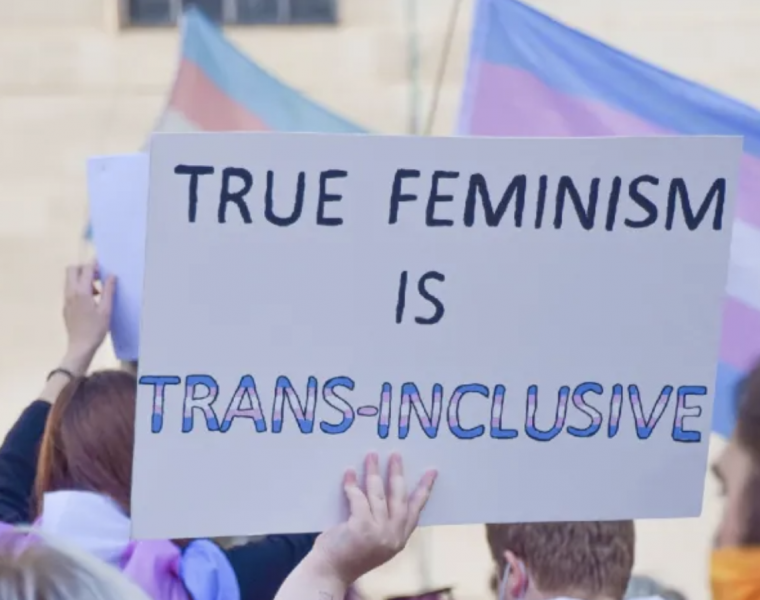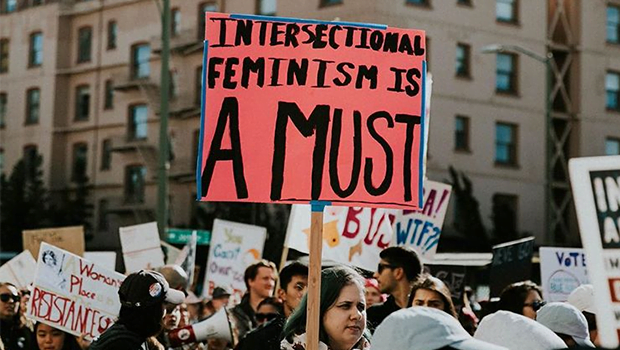In today’s conversations on feminism in public discourse and social media, we have been able to introduce the necessity of recognising and valuing intersections. These intersections come in terms of caste, class, colour, gender, sexuality and so on. In addressing systemic disenfranchisement of identities in the patriarchal construct, women are often enumerated in archaic terms and herded under a common umbrella for ease of online social justice discourse.
In the public and online spaces of urban feminism, intersectionality is a term used with little functionality and the cis-het Savarna Indian women occupy the lion’s share of this space. These self-important voices have often marginalised the trans community. The late Kamla Bhasin, known for her extensive work in the Indian feminist space, was found of exclusionary opinion at a workshop called ‘Artivism 101: Sangat’s Creative Workshop‘.
Bhasin mentioned that feminism was not about race, caste, ecology or trans issues, but exclusively about patriarchy, misogyny and the power wielded by “men” over “women”. She later apologised unconditionally when there were voices rising against her statements. But her words reflect the intersectionality-blindness existing in the feminist spaces in India. Even as we have rapidly refined our words, and policed our tones for the public political image of a feminist, the cis-het Savarna spaces continue to treat Dalit or trans rights as peripheral.
Abu Sohel Khondekar, Kolkata-based artist and photographer, shared her experience of navigating these spaces. Abu Sohel says, “Since Transgender women are the most vocal and visible demographic (amongst Trans people) in the Queer community in India/Kolkata, they are also the most widely discriminated.”
Even before she came out as non-binary trans, she has observed how these popular spaces treated trans women. The academic space has evolved itself to pose as a woke space to discuss gender and sexual identities. But it is in such conferences discussing queer issues that cis-women assume the lead and trans voices are often “seen and painted as problem creators”. Soft feminism, tolerable feminism, drawing room feminism – we can define them in many ways.
What makes bodies male and female? The identity and location of women have been defined by an absence or lack. Be it Aristotle saying “The female is a female by virtue of a certain lack of qualities” or St. Thomas postulating a woman as an “imperfect man” – the lines that have been drawn in the name of biology, psychology of femininity, and masculinity continue to define the cis-het Savarna feminist discourse in India
The angry feminist is a bane of existence. Making the feminist discourse palatable, spoken in soft “feminine” jousts is a common priority. Abu Sohel confirms that the angry feminist is a bigger headache when she is trans. “We are often tone-shamed for our bursts of anger, but the anger arises from not being heard in the first place. People only see us raging but not the causes (which in many cases are the people themselves) which makes us angry, thus, only treating the symptoms and not the cause.”
Tejaswi, Digital Editor at Gaysi Family, shared their recent experience of vicious trolling. They had commented on a post related to the recent ban on trans women athletes based on the category they are allowed to compete in. The post quoted a cis-male British sports philosopher, “…and the trolls just came for me when I spoke.”
They had commented on how mixed-gender categories should be introduced in sports, which was met with trolling and angry comments regarding hormonal support being different for men and women, etc. The internet is built with binary and supports polarity. Nuances and constructive arguments rarely find a safe space online.
Tejaswi adds that, “Most trans people are not vocal online because there is a lot of violence against them”. Instead, the alternative space and community created by trans people and queer folx are much more necessary than expending energy and peace online. Tejaswi observes that cis-het women, especially Savarna or White, do not reciprocate the political effort queer folx exert to deconstruct gender. “It is as toxic as a woman having to sit in a boy’s club and explain feminism and doing all the emotional labour.”

Abu Sohel mentions in her response, “Technically, a large chunk of the Trans population, Enbies like me, don’t even exist for most feminist circles, probably because we don’t exist in a census and even if we exist for them, they are very dismissive of us.”
A brief phone call with Nandini Moitra, artist and co-founder of Amra Odbhuth cafe, revealed similar patterns as they added how these spaces invisibilise asexuality. Navigating the urban feminist circles required them to explain and justify their sexuality. These spaces operate with a sense of entitlement where individuals from non-cishet-Savarna identities have to justify their intersectional location and experience. Tejaswi added to this thought saying, “There is no visible effort to showcase that hey maybe we haven’t thought outside our own identities or conditioning… it is always a performative wokeness.”
Abu Sohel shared that she has been refused the space she rightfully belongs to based on her “look and appearance”. A beard is synonymous with being a man. “I have been told by many angry feminists in the past that I can’t be a feminist because I have a beard. People also generally assume that I am a man, based on my look & appearance, without even feeling the need to ask me for my pronouns.”
What makes bodies male and female? The identity and location of women have been defined by an absence or lack. Be it Aristotle saying “The female is a female by virtue of a certain lack of qualities” or St. Thomas postulating a woman as an “imperfect man
